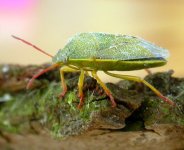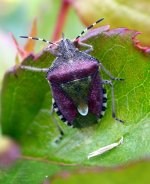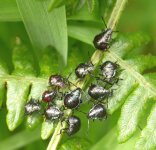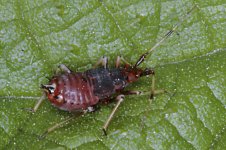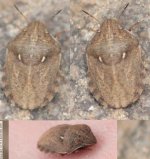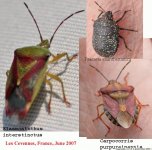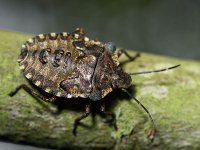-
Welcome to BirdForum, the internet's largest birding community with thousands of members from all over the world. The forums are dedicated to wild birds, birding, binoculars and equipment and all that goes with it.
Please register for an account to take part in the discussions in the forum, post your pictures in the gallery and more.
You are using an out of date browser. It may not display this or other websites correctly.
You should upgrade or use an alternative browser.
You should upgrade or use an alternative browser.
Shieldbugs. (3 Viewers)
- Thread starter Tammie
- Start date
More options
Who Replied?Surreybirder
Ken Noble
I think it looks more like a gorse shieldbug. What was it on?
It was on my shirt! There's not much in my area in the way of gorse or broom. Although I suppose some neighbour may have broom.
I don't know if a side view helps? (It's quite a colourful insect seen from this angle!)
Ken
Attachments
harry eales
Ancient Entomologist
I thought this must be a green shieldbug but having seen the posts above I'm not so sure.
Your not alone Ken, I had to do a double take as well.
It's a Gorse Shieldbug, although it doesn't have it's usual bronze colouring. The give-aways are the antennae and the colour of the lower parts of the legs.
In the Green Shieldbug the antennae have dark banding, and the legs are all green.
Other similar species are N, viridula a slightly larger green Shieldbug which is now a resident breeding species in parts of southern England, but the specimen photographed does not have the band of small white spots along the joint line of the pronotum and scutellum.
Lastly the other possibility of P.juniperina was considered momentarily (it has been extince in Britain for about 80 years) and rejected as it has dark antennae, all green legs and a visible yellow outline to the pronotum when viewed from above.
An interesting colour variant of the Gorse Shieldbug.
Harry
Surreybirder
Ken Noble
Thanks, Harry.
Does this species live on plants other than gorse?
Ken
Does this species live on plants other than gorse?
Ken
harry eales
Ancient Entomologist
Thanks, Harry.
Does this species live on plants other than gorse?
Ken
Hello Ken,
Yes it does, it is more easily found on Gorse but also feeds on the pods of Broom and Laburnum and no doubt the similar seed pods of some Legumes.
I have beaten nymphs of Blackberry in the past.
Like many bugs named after plants, they are not confined to those plants after which they are named.
Harry
Surreybirder
Ken Noble
Hi, Harry,
Thanks for the info. I don't know what plant it was visiting but I'm sure that some of those you mention must occur near me.
Ken
Thanks for the info. I don't know what plant it was visiting but I'm sure that some of those you mention must occur near me.
Ken
Surreybirder
Ken Noble
harry eales
Ancient Entomologist
Would I be correct in guessing that this is the hawthorn shieldbug?
I found it in the garden this a.m. when trying to photograph a very unobliging hoverfly.
Ken
Hello Ken,
No, you would be incorrect. lol.
It's a Sloe Shieldbug. D. baccarum.
Harry
Surreybirder
Ken Noble
Hello Ken,
No, you would be incorrect. lol.
It's a Sloe Shieldbug. D. baccarum.
Harry
Well, I guess that goes to show that I'm not too quick at picking up shieldbug ID
But thanks for the ID.
Ken
steve covey
Jack of all Orders - Master of None
Well, I guess that goes to show that I'm not too quick at picking up shieldbug ID
But thanks for the ID.
Ken
Talking of Sloe's I saw some early instar nymphs on Friday which I am guessing may be this species - but I could be wrong, and probably am!
Cheers,
Steve.
Attachments
harry eales
Ancient Entomologist
Talking of Sloe's I saw some early instar nymphs on Friday which I am guessing may be this species - but I could be wrong, and probably am!
Cheers,
Steve.
Hello Steve,
First instar Shieldbug nymphs are notoriously difficult to ID. Some even change colour and pattern from instar to instar.
In the case of those in your picture, I'll be honest, I don't know either.
It may pay you to go back in a week or two's time and try beating for some of them. If unsure, try and breed some through.
Harry
138mph
Well-known member

jc001
Well-known member
Hi,
If possible,please could anyone help me to id this lovely little fella?
Found in rural sussex low down on a willow tree,maybe 10-12mm.
I wondered about a young forest bug,because of the hint of shoulderpads? but im far from an expert on bugs to say the least.
thanks
jc
If possible,please could anyone help me to id this lovely little fella?
Found in rural sussex low down on a willow tree,maybe 10-12mm.
I wondered about a young forest bug,because of the hint of shoulderpads? but im far from an expert on bugs to say the least.
thanks
jc
Attachments
harry eales
Ancient Entomologist
Hi,
If possible,please could anyone help me to id this lovely little fella?
Found in rural sussex low down on a willow tree,maybe 10-12mm.
I wondered about a young forest bug,because of the hint of shoulderpads? but im far from an expert on bugs to say the least.
thanks
jc
Hello JC,
You are correct, it is a nymph of the P.rufipes, The Forest Shieldbug.
Harry
harry eales
Ancient Entomologist
Just back from Les Cévennes in Southern France.
I think the shield bugs are:
Eurygaster maura? and
Elasmostethus interstinctus, Psacasta exanthematica, Carpocorris purpureipennis.
Hugh
Hello Hugh,
I think your first pics are of Eurygaster testudinaria, the patterns on the scutellum and wing cases are quite distinctive. I'll have to find my German book on the others before making any comment on the others.
Harry
Hello, my name is Ryan. I am from Ambridge, Pennsylvania (USA) which is close to the large city of Pittsburgh, Pennsylvania.
I realize that, through reading this thread, most of you are very fond of these creatures. However, I have a bit of a problem and don't know exactly where to turn for solutions except here.
At least once a month for the last year maybe, I have noticed a certain species of these stink/shield bugs in my house. Generally it seems as if it was fluttering down from my attic to my room (the attic is right above the ceiling and small gaps exist). Though I've seen them in other rooms on the second floor of my house as well.
Through some research and looking around at photos I've come to thinking that this is a Raphigaster nebulosa (as a little side question, is it Rhaphigaster or Raphigaster? Wikipedia says Raphigaster but Google says "did you mean Rhaphigaster?" and I get more results that way). I don't have any pictures of my own but can find a way to take some if desired.
I was just curious as to why they might be in my house, whether or not they're coming in or living in, and what kind of population of them might exist outside or inside my house considering that. Any answers to those questions would be greatly appreciated. I would also like to know if there is any way to prevent them from coming in.
Thank you for your time. I appreciate any help I receive on this matter.
--
Ryan
I realize that, through reading this thread, most of you are very fond of these creatures. However, I have a bit of a problem and don't know exactly where to turn for solutions except here.
At least once a month for the last year maybe, I have noticed a certain species of these stink/shield bugs in my house. Generally it seems as if it was fluttering down from my attic to my room (the attic is right above the ceiling and small gaps exist). Though I've seen them in other rooms on the second floor of my house as well.
Through some research and looking around at photos I've come to thinking that this is a Raphigaster nebulosa (as a little side question, is it Rhaphigaster or Raphigaster? Wikipedia says Raphigaster but Google says "did you mean Rhaphigaster?" and I get more results that way). I don't have any pictures of my own but can find a way to take some if desired.
I was just curious as to why they might be in my house, whether or not they're coming in or living in, and what kind of population of them might exist outside or inside my house considering that. Any answers to those questions would be greatly appreciated. I would also like to know if there is any way to prevent them from coming in.
Thank you for your time. I appreciate any help I receive on this matter.
--
Ryan
harry eales
Ancient Entomologist
Hello Ryan,
Shieldbugs, as you probably already know feed, as both nymphs and adults on either sap or juices from various plants and trees or from the liquid contents of insect larvae, caterpillars etc.
Most, but not all, species hibernate during the winter months as adults, these hibernating sites can vary from under loose bark, in moss or in buildings etc.
Entry to houses is relatively simple for them, ventilator bricks, cracks in joints, roofing tiles or shingles, any small hole can be utilised by them to gain access.
Just when they emerge from hibernation, depends upon temperature, and as this can vary according to the site chosen for hibernation, they emerge often over a period of two or three months, during the spring.
If you are getting them all year round it's likely that some are landing on your roof during such times as they take flight and to avoid exposure to either predators or inclement weather they take shelter under whatever roof covering you have.
Like many other insect species thay are also attracted to light and if you have a window open at night they may well fly in.
There is nothing in a house that would naturally attract them other than what I have mentioned above. They present no danger at all to humans and they're probably just as anxious to get out of your home as you are to have them gone.
It's not a species which occurs in Britain, but it is common in southern Europe and perhaps elsewhere around the world. I see that according to various websites that it is commonly found in houses. If this is so, then it's likely that it is open windows in lit rooms at night that is attracting them into your home.
This may be a slight inconvenience to you, but far less so perhaps, than having mice take up residence.
Harry
Shieldbugs, as you probably already know feed, as both nymphs and adults on either sap or juices from various plants and trees or from the liquid contents of insect larvae, caterpillars etc.
Most, but not all, species hibernate during the winter months as adults, these hibernating sites can vary from under loose bark, in moss or in buildings etc.
Entry to houses is relatively simple for them, ventilator bricks, cracks in joints, roofing tiles or shingles, any small hole can be utilised by them to gain access.
Just when they emerge from hibernation, depends upon temperature, and as this can vary according to the site chosen for hibernation, they emerge often over a period of two or three months, during the spring.
If you are getting them all year round it's likely that some are landing on your roof during such times as they take flight and to avoid exposure to either predators or inclement weather they take shelter under whatever roof covering you have.
Like many other insect species thay are also attracted to light and if you have a window open at night they may well fly in.
There is nothing in a house that would naturally attract them other than what I have mentioned above. They present no danger at all to humans and they're probably just as anxious to get out of your home as you are to have them gone.
It's not a species which occurs in Britain, but it is common in southern Europe and perhaps elsewhere around the world. I see that according to various websites that it is commonly found in houses. If this is so, then it's likely that it is open windows in lit rooms at night that is attracting them into your home.
This may be a slight inconvenience to you, but far less so perhaps, than having mice take up residence.
Harry
Users who are viewing this thread
Total: 4 (members: 0, guests: 4)




